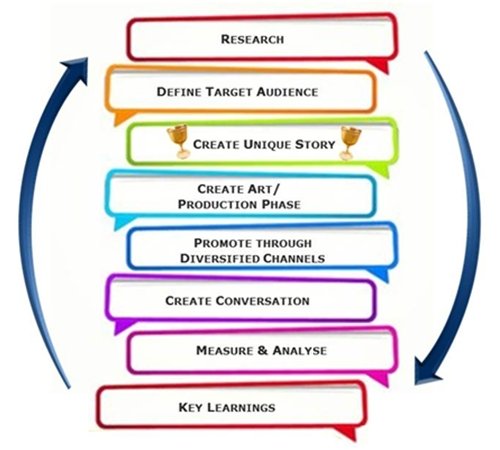Strategy is intrinsic to content marketing: You have to have a well-considered approach to the creation and distribution of valuable and relevant content to prospective customers.
That should be nothing new, but the criticality of having a documented content marketing strategy is.
Seems like common sense to put a content strategy and plan in writing, right? But, only 32% of B2B marketers say they have a documented content marketing strategy, and 48% say they have a strategy but it's not documented, according to research by the Content Marketing Institute and MarketingProfs.
Yet, "B2B content marketers who document their strategy are more effective in nearly all areas of content marketing, the research consistently shows," CMI and MarketingProfs affirm.
Digital and social marketing have amplified the need for a strategic approach to content. More content is floating around in more channels than ever before—exponentially more than when Bill Gates declared "content is king" nearly 20 years ago.
More Channels = More Content = More Complexity. It's that simple.
With ever more content being created and disseminated via ever-evolving distribution points, marketing is undergoing constant transformation. This increased complexity requires not only experienced content strategists but also a well-documented plan for marketing teams to communicate and follow. Sounds like common sense...
So, how do you build a content marketing strategy? Follow the following steps and repeat.

1. Research your competitors, target audiences, and overall marketplace
The main purpose of the effort is to determine your distinct differentiators. The research and subsequent introspection provide the foundation for your marketing strategy and tactics.
- Determine your top three differentiators or competitive advantages. For example, "great customer support," though important, is not a point of differentiation; many of your competitors will claim the same thing. A point of differentiation is something not replicated, such as a proprietary process, historic milestone, and product feature/functionality.
- Do some general marketplace research. For example, is there upcoming legislation that will have an impact on your services? Supply surpluses or shortages? Technology advancements?
- Know your customer demographics and preferences. The more you know about your customers, the more you'll sell and outperform competitors—and the more you'll understand about how to position your services to potential buyers. You can undertake cost-conscious survey research (via SurveyMonkey, for example), or if budget permits you can use marketing automation that aggregates data and performs constant monitoring across platforms so that your customer profile remains up to date (HubSpot, Marketo, etc.).
2. Define your target audiences
Use the information you've collected in step one to define your target audience and create a customer profile using demographics as well as psychographics. You'll find you may have multiple customer profiles and therefore multiple messages and strategies within an overarching strategy.
For example, Ford may look to increase overall sales 5%. That may be a simply-stated goal, but the strategy for getting there is complex: Ford sells a spectrum of automobiles and therefore has numerous customer profiles. Whereas, Ferrari, for example, has one defined customer profile (as of five years ago): average age 47 years old (in North America), 45% entrepreneurs, and 45% with a PhD or MBA.
Ford's audience, however, is not so well defined. With multiple customer profiles and multiple strategies that roll up under one unifying brand, "We define a 'brand DNA' and a 'target customer' for each of our main brands and products. The brand DNA and target customer profiles go beyond simple demographic information such as age, gender and income; we build complete profiles of our target customer, including information such as what they like to do, what music they listen to and where they shop," Ford explains.
3. Create a unique story
Use the research you've done so far to create a story that's unique to your brand, service, or company. This is the absolute Holy Grail and most important step of all. If you don't have something of value to say, why should anyone listen? Do your homework in step one. If you have strong differentiators, you won't be grasping at straws and copying competitors. You'll have discovered your value positioning and the truth in your marketing story.
4. Create art/produce creative
This is the marriage of strategy and creativity to ultimately tell your story via compelling creative produced for the channels you've secured (print, digital, social, direct mail, PR, event, tradeshow, etc.).
5. Promotion and distribution through diversified channels
Content marketing is a way of life now—it's just the way marketing is done. Meaning, you need to connect with your target audiences where they choose to converse—from social media to event marketing and everywhere in between. But don't put it out there and walk away. Many channels require constant care—and a strategy for steering customers where you want them to go.
6. Create conversation—where possible
The story you put out there is good if it starts a conversation. It means your audience didn't just look at it... they spent time with it. Why would they spend time with it? Because it holds value for them. And, keep in mind that social media is the most cost-effective channel for both starting conversations and keeping them going.
7. Measure—when possible
Measurement is key for knowing what to replicate in the future and what to change, but it's not practical for every marketing channel. Just because your efforts aren't measureable, however, doesn't mean they're ineffective: Creating brand awareness is often not measurable, but it pays dividends down the road.
8. Reflect on key learnings
Marketers often skip this step because they get lost in daily minutiae and they are continually putting out fires, but take the time to reflect so you can duplicate successes and avoid mistakes.




